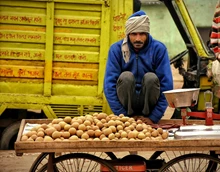Agricultural commodity prices, particularly wheat, maize, soyabean, and palm oil, fell sharply in the global market over the weekend after surging on February 24 when Russia ordered its troops into Ukraine. The prices of most of these commodities have dropped by more than 5% as members of the North Atlantic Treaty Organization (NATO), led by the United States, and other countries critical of Moscow's actions have failed to reach an agreement that will affect the movement of foodgrains such as maize, wheat, and sunflower.
Bio-Diesel Demand
According to traders, concerns about the supply of these commodities have subsided in some ways. Palm oil spot prices fell over the weekend to 6,732 MYR per tonne after reaching a high of 7,000 MYR on February 24. The benchmark May futures contract fell below 6,000 MYR to 5,984 MYR.
During the weekend, March contracts of canola, a type of rapeseed, fell by more than 5% to $1,008.10 per tonne on the Intercontinental Exchange.
Prices for palm oil and canola have risen due to two factors. One, market participants were concerned that supplies of sunflower oil from Ukraine, the primary supplier, would be disrupted. Second, whenever crude oil prices reach around $100 per barrel, both of these oils are diverted for the production of biodiesel.
Wheat and maize prices have also risen on fears that supply from Russia and Ukraine, both major exporters on the global market, may be disrupted.
There are two sources of concern. The first is that Russia may prevent Ukraine from exporting these commodities, and the second is that any sanctions imposed by NATO and its allies may have an impact on Russian shipments to the global market.
Moscow, Kyiv Global Exports Share
Even barley prices have risen as Russia (4.96 million tonnes or mt) and Ukraine (5.04 mt) account for more than 40% of the global supply.
In the case of sunflower oil, Ukraine (6.86 mt) and Russia (3.2) almost make up the entire global supply of 11.24 mt. Again Moscow (37.26 mt) and Kyiv (18.05 mt) contribute over 25 percent of exports in the world wheat market.
In terms of maize, both of these countries (Russia 2.28 mt and Ukraine 27.95 mt) have shipped out nearly 10% of global exports of 305.54 mt.
India an Export Source
The rise in commodity prices has benefited Indian farmers to some extent. Prices rose as tensions between Moscow and Kyiv rose, peaking on the day Putin announced his decision. However, rates fell slightly over the weekend.
This is because India is viewed as a source capable of meeting short-term needs and supplying in small quantities for such urgent needs. It can, in particular, meet the needs of countries in South Asia, South-East Asia, and West Asia, in addition to Africa.
Other benefits that New Delhi enjoys include price competitiveness and ample stocks in the country, which have been bolstered by the record production of these grains.
Oil Imports Turn Costly
Oilseed prices, on the other hand, have risen as imports of oils such as palm, soyabean, and sunflower become more expensive.
The global market's reaction to the Ukraine crisis was mirrored in domestic agricultural markets as well. Wheat prices topped 2,000 per quintal last week, with Madhya Pradesh accounting for the highest arrival of 63,713 tonnes.
Maize prices are hovering around $1,900 per quintal, with Madhya Pradesh once again accounting for the majority of arrivals (19,043). Soybean prices are firmly above 6,000 per quintal in various agricultural markets, and mustard rates are also firm around these levels. Last week, Maharashtra and Madhya Pradesh accounted for more than 90% of soyabean arrivals, while Rajasthan, Madhya Pradesh, and Gujarat made up over 80 percent.











